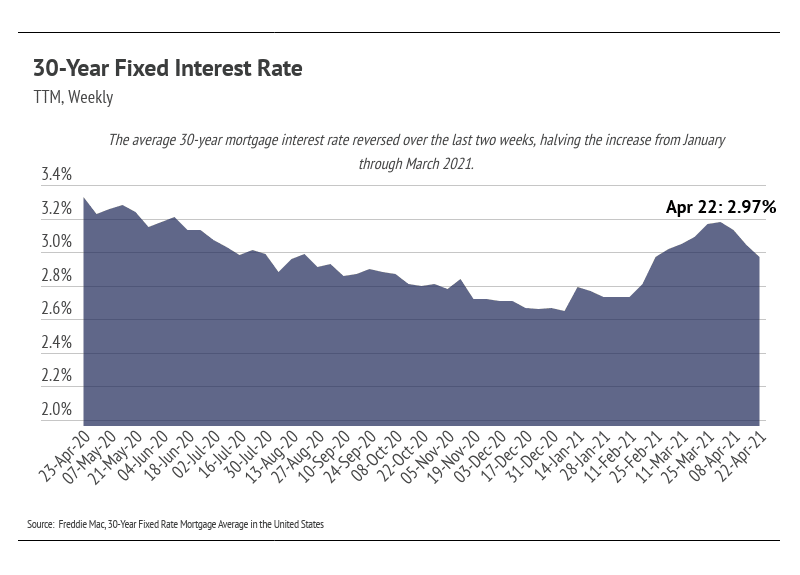May Newsletter – Key Topics and Trends


Last year, many individuals and families experienced feast or famine. Those lucky enough to stay financially unaffected by the pandemic were likely saving or investing more than expected, accruing more and more capital. At the same time, interest rates plummeted to hyperlow levels as millennials, the largest living adult generation, grew to prime homeownership age. With these factors combined, we saw the demand for homes skyrocket in 2020. The near-universal ability to work remotely changed motivations for moving. Relocating for a job or to be closer to the office was no longer necessary. However, due to the unique requirements of working from home, people began wanting more space. As a result, single-family home demand rose steeply, while condo demand lagged. As sellers listed condos, they bought single-family homes, driving single-family home inventory down. As the supply of homes declined, fewer new listings came to market—in part, because of the difficulty of finding a new home after selling.
One reason for the housing shortage has been the understandable hesitancy of builders to construct new properties since the 2006–2008 housing crash; however, this lack of new construction means that there aren’t enough homes on the market to meet the unexpectedly high demand. Over the last six months, new construction has ramped up considerably to an annualized 1.74 million new homes. The largest gains in new-home construction occurred in the Midwest, where housing starts more than doubled on a monthly basis. The Northeast and the South also saw faster rates of new-home construction, while home-building activity slowed in the West. Additionally, established metro areas lack land upon which to build, so adding meaningfully to supply through new construction can be challenging or fully unattainable.
As you can see from the chart below, new construction is now in the pre-housing bubble levels as home builders react to the surge in home prices and demand.

Mortgage rates rose significantly, slightly over 50 basis points, from January 2021 to mid-April 2021, but dropped sharply back below 3% in the second half of April. Although interest rates are still expected to rise to 3.7% over the course of the year, according to the Mortgage Bankers Association, the mortgage rate drop shows the non-linear path that rates will likely take. Because the mortgage rate affects affordability, the current low rate will only increase demand in the short term.

High unemployment is one of the strongest predictors of falling home prices over a two-year period. The chart below illustrates the employment cost of a recession. Total employment tends to grow at a fairly consistent rate during economic expansions. The green line illustrates the expected level of employment had the pandemic never happened. As that green line shows, we are nearly 11 million jobs below where employment was expected to be after the first quarter of 2021. Twice as many workers are currently unemployed than in February 2020. The initial pain of unemployment has been dampened by government relief. Mortgages in forbearance and foreclosures are low, as are delinquencies in credit card debt. However, we will continue to monitor unemployment in order to gauge future market conditions.

Although we don’t expect the same level of buying in 2021 that we saw in 2020, the environment is right for demand to outpace supply in 2021. In the short term, we may even see a demand spike as potential buyers try to purchase before rates rise higher. As a result, we anticipate a competitive landscape for buyers over the course of this year.
While the market remains competitive for buyers, conditions are making it an exceptional time for homeowners to sell. Low inventory means multiple offers and fewer concessions. Because sellers are often selling one home and buying another, it is essential that sellers work with the right agent to ensure the transition goes smoothly.
Our team is committed to continuing to serve all your real estate needs while incorporating safety protocol to protect all of our loved ones.
In addition, as your local real estate experts, we feel it’s our duty to give you, our valued client, all the information you need to better understand our local real estate market. Whether you’re buying or selling, we want to make sure you have the best, most pertinent information, so we’ve put together this monthly analysis breaking down specifics about the market.
As we all navigate this together, please don’t hesitate to reach out to us with any questions or concerns. We’re here to support you.
Stay up to date on the latest real estate trends.

HAYLEN was selected for its culturally aligned, people-first advisory approach, supporting the Nikkei-rooted organization through a values-driven real estate transition





You’ve got questions and we can’t wait to answer them.